Impact of Recycled Concrete and Brick Aggregates on the Flexural and Bond Performance of Reinforced Concrete
Abstract
:1. Introduction
2. Experimental Program
2.1. Materials
2.2. Concrete Mixes
2.3. Test Specimens
3. Test Methods
3.1. Density
3.2. Test for Compressive Strength
3.3. Pullout Tests
3.4. Flexural Test
4. Results and Discussion
4.1. Density
4.2. Compressive Strength
4.3. Bond Strength
Prediction of Bond Strength
4.4. Flexural Test Results
4.4.1. Load–Deflection Response
4.4.2. Cracking and Yielding Moments
4.4.3. Cracking Patterns of RC Beams
5. Conclusions
- (1)
- The reduction in both compressive and bond strengths was observed with the increase in the content of coarse RAs in the mix composition. However, with a 50% replacement of NAs by RAs, the decrease in properties was insignificant. This highlights the potential of incorporating recycled materials into concrete mixes as a viable option for achieving satisfactory strength levels.
- (2)
- Among all tested specimens, the experimentally measured bond strengths exceeded the design values predicted using the empirical model proposed by ACI 318, indicating favorable bonding performance. Notably, while comparing specimens containing coarse RCAs to those prepared with coarse RBAs with the addition of any fine aggregate (RCA or RBA), a slightly higher bond strength was observed in the former.
- (3)
- The cracking and yielding stiffness of the beams show improvement for the specimens prepared with a higher content of coarse NAs. These findings highlight the influence of NAs on the stiffness characteristics of the beams, indicating that increasing the quantity of NAs can enhance the structural performance and load-bearing capacity of the concrete elements. However, the specimen containing 50% recycled coarse aggregates also showed comparable performance to the controlled specimen.
- (4)
- In the case of beams containing recycled coarse aggregates, an expanded pattern with a greater number of cracks was observed. On the other hand, beams with natural coarse aggregate and controlled specimens exhibited a squeezed pattern with fewer cracks. This disparity in crack patterns suggests that the use of recycled coarse aggregates can lead to increased cracking and a more dispersed distribution of cracks compared to beams with natural coarse aggregate. However, with the partial replacement of NAs by RAs, less damage was observed for the specimens in the presence of a higher content of NAs.
Author Contributions
Funding
Institutional Review Board Statement
Informed Consent Statement
Data Availability Statement
Acknowledgments
Conflicts of Interest
References
- Aitkin, P.-C. Cements of yesterday and today: Concrete of tomorrow. Cem. Concr. Res. 2000, 30, 1349–1359. [Google Scholar]
- Dalkılıç, N.; Nabikoğlu, A. Traditional manufacturing of clay brick used in the historical buildings of Diyarbakir (Turkey). Front. Arch. Res. 2017, 6, 346–359. [Google Scholar] [CrossRef]
- Global Cement and Concrete Association (GCCA). Global Cement and Concrete Industry Announces Roadmap to Achieve Ground-Breaking ‘Net Zero’CO2 Emissions by 2050; Global Cement and Concrete Association (GCCA): London, UK, 2021. [Google Scholar]
- Moujoud, Z.; Harrati, A.; Manni, A.; Naim, A.; El Bouari, A.; Tanane, O. Study of fired clay bricks with coconut shell waste as a renewable pore-forming agent: Technological, mechanical, and thermal properties. J. Build. Eng. 2023, 68, 106107. [Google Scholar] [CrossRef]
- Weyant, C.; Kumar, S.; Maithel, S.; Thompson, R.; Baum, E.; Floess, E.; Bond, T. Brick Kiln Measurement Guidelines: Emissions and Energy Performance; Climate and Clean Air Coalition: Paris, France, 2016. [Google Scholar]
- Anike, E.E.; Saidani, M.; Ganjian, E.; Tyrer, M.; Olubanwo, A.O. Evaluation of conventional and equivalent mortar volume mix design methods for recycled aggregate concrete. Mater. Struct. 2020, 53, 22. [Google Scholar] [CrossRef]
- Gyawali, T.R. Re-use of concrete/brick debris emerged from big earthquake in recycled concrete with zero residues. Clean. Waste Syst. 2022, 2, 100007. [Google Scholar] [CrossRef]
- Mountains of Debris’ Rise in Türkiye’s Quake-Hit Regions. Bianet—Bagimsiz Iletisim Agi. Available online: https://www.bianet.org/english/environment/274692-mountains-of-debris-rise-in-turkiye-s-quake-hit-regions (accessed on 1 August 2023).
- Ahmad, M.; Hameed, R.; Shahzad, S.; Sohail, M.G. Performance Evaluation of Loadbearing Compressed Fully Recycled Aggregate Concrete Bricks; Elsevier: Amsterdam, The Netherlands, 2023; pp. 1235–1249. [Google Scholar]
- Farooq, M.U.; Hameed, R.; Tahir, M.; Sohail, M.G.; Shahzad, S. Mechanical and durability performance of 100% recycled aggregate concrete pavers made by compression casting. J. Build. Eng. 2023, 73, 106729. [Google Scholar] [CrossRef]
- Hameed, R.; Imran, M.; Hassan, M.I.; Arshad, E. Mechanical performance of 100% recycled aggregate concrete (RAC) bricks. Rev. Constr. 2023, 22, 203–222. [Google Scholar] [CrossRef]
- Anike, E.E.; Saidani, M.; Ganjian, E.; Tyrer, M.; Olubanwo, A.O. The potency of recycled aggregate in new concrete: A review. Constr. Innov. 2019, 19, 594–613. [Google Scholar] [CrossRef]
- Ghalehnovi, M.; Roshan, N.; Hakak, E.; Shamsabadi, E.A.; De Brito, J. Effect of red mud (bauxite residue) as cement re-placement on the properties of self-compacting concrete incorporating various fillers. J. Clean. Prod. 2019, 240, 118213. [Google Scholar] [CrossRef]
- Tejas, S.; Pasla, D. Assessment of mechanical and durability properties of composite cement-based recycled aggregate concrete. Constr. Build. Mater. 2023, 387, 131620. [Google Scholar] [CrossRef]
- Russo, N.; Lollini, F. Effect of carbonated recycled coarse aggregates on the mechanical and durability properties of concrete. J. Build. Eng. 2022, 51, 104290. [Google Scholar] [CrossRef]
- Martínez-García, R.; de Rojas, M.S.; Jagadesh, P.; López-Gayarre, F.; Morán-Del-Pozo, J.M.; Juan-Valdes, A. Effect of pores on the mechanical and durability properties on high strength recycled fine aggregate mortar. Case Stud. Constr. Mater. 2022, 16, e01050. [Google Scholar] [CrossRef]
- Reddy, R.S.R.; Sagar, B.A. Experimental study on mechanical and durability properties of recycled aggregate based geo-polymer concrete. Mater. Today: Proc. 2022, 52, 649–654. [Google Scholar] [CrossRef]
- Hameed, R.; Tahir, M.; Shahzad, S.; Kazmi, S.M.S.; Munir, M.J. Impact of Compression Casting Technique on the Mechanical Properties of 100% Recycled Aggregate Concrete. Sustainability 2023, 15, 8153. [Google Scholar] [CrossRef]
- Adessina, A.; Ben Fraj, A.; Barthélémy, J.-F. Improvement of the compressive strength of recycled aggregate concretes and relative effects on durability properties. Constr. Build. Mater. 2023, 384, 131447. [Google Scholar] [CrossRef]
- Schubert, S.; Hoffmann, C.; Leemann, A.; Moser, K.; Motavalli, M. Recycled aggregate concrete: Experimental shear resistance of slabs without shear reinforcement. Eng. Struct. 2012, 41, 490–497. [Google Scholar] [CrossRef]
- Zhang, J.; Wang, F.; Zhao, D.; Zhang, M.; Cao, W. Seismic performance of resilient recycled aggregate piloti-type structure employing ultra-high strength bars. Eng. Struct. 2023, 282, 115795. [Google Scholar] [CrossRef]
- Zhang, J.; Li, C.; Ding, L.; Li, J. Performance evaluation of cement stabilized recycled mixture with recycled concrete aggregate and crushed brick. Constr. Build. Mater. 2021, 296, 123596. [Google Scholar] [CrossRef]
- Gao, D.; Jing, J.; Chen, G.; Yang, L. Experimental investigation on flexural behavior of hybrid fibers reinforced recycled brick aggregates concrete. Constr. Build. Mater. 2019, 227, 116652. [Google Scholar] [CrossRef]
- Mohammed, T.U.; Shikdar, K.H.; Awal, M. Shear strength of RC beam made with recycled brick aggregate. Eng. Struct. 2019, 189, 497–508. [Google Scholar] [CrossRef]
- González, J.S.; Gayarre, F.L.; Pérez, C.L.-C.; Ros, P.S.; López, M.A.S. Influence of recycled brick aggregates on properties of structural concrete for manufacturing precast prestressed beams. Constr. Build. Mater. 2017, 149, 507–514. [Google Scholar] [CrossRef]
- Visintin, P.; Dadd, L.; Alam, M.U.; Xie, T.; Bennett, B. Flexural performance and life-cycle assessment of multi-generation recycled aggregate concrete beams. J. Clean. Prod. 2022, 360, 132214. [Google Scholar] [CrossRef]
- Anike, E.E.; Saidani, M.; Olubanwo, A.O.; Anya, U.C. Flexural Performance of Reinforced Concrete Beams with Recycled Aggregates and Steel Fibres; Elsevier: Amsterdam, The Netherlands, 2022; pp. 1264–1278. [Google Scholar]
- Özkılıç, Y.O.; Başaran, B.; Aksoylu, C.; Karalar, M.; Martins, C.H. Mechanical behavior in terms of shear and bending performance of reinforced concrete beam using waste fire clay as replacement of aggregate. Case Stud. Constr. Mater. 2023, 18, e02104. [Google Scholar] [CrossRef]
- Wang, J.; Xu, Q. The combined effect of load and corrosion on the flexural performance of recycled aggregate concrete beams. Struct. Concr. 2023, 24, 359–373. [Google Scholar] [CrossRef]
- Guan, Q.; Yang, M.; Shi, K.; Zhang, T. Experimental Study and Finite Element Analysis on the Flexural Behavior of Steel Fiber Reinforced Recycled Aggregate Concrete Beams. Materials 2022, 15, 8210. [Google Scholar] [CrossRef] [PubMed]
- Tang, L.; Liu, T.; Sun, P.; Wang, Y.; Liu, G. Sisal fiber modified construction waste recycled brick as building material: Properties, performance and applications. Structures 2022, 46, 927–935. [Google Scholar] [CrossRef]
- Saha, A.S.; Amanat, K.M. Rebound hammer test to predict in-situ strength of concrete using recycled concrete aggregates, brick chips and stone chips. Constr. Build. Mater. 2021, 268, 121088. [Google Scholar] [CrossRef]
- Xiong, B.; Demartino, C.; Xu, J.; Simi, A.; Marano, G.C.; Xiao, Y. High-strain rate compressive behavior of concrete made with substituted coarse aggregates: Recycled crushed concrete and clay bricks. Constr. Build. Mater. 2021, 301, 123875. [Google Scholar] [CrossRef]
- Meng, T.; Wei, H.; Dai, D.; Liao, J.; Ahmed, S. Effect of brick aggregate on failure process of mixed recycled aggregate concrete via X-CT. Constr. Build. Mater. 2022, 327, 126934. [Google Scholar] [CrossRef]
- Dang, J.; Xiao, J.; Duan, Z. Effect of pore structure and morphological characteristics of recycled fine aggregates from clay bricks on mechanical properties of concrete. Constr. Build. Mater. 2022, 358, 129455. [Google Scholar] [CrossRef]
- ACI-Committee 408; Bond and Development of Straight Reinforcing Bars in Tension. American Concrete Institute: Farmington Hills, MI, USA, 2003.
- Lopez, J.E.; Paz, S.S.; Fonteboa, B.G.; Abella, F.M. Bond behavior of recycled concrete: Analysis and prediction of bond stress-slip curve. J. Mater. Civ. Eng. 2017, 29, 04017156. [Google Scholar] [CrossRef]
- Harajli, M.H. Comparison of Bond Strength of Steel Bars in Normal- and High-Strength Concrete. J. Mater. Civ. Eng. 2004, 16, 365–374. [Google Scholar] [CrossRef]
- Zuo, J.; Darwin, D. Splice strength of conventional and high relative rib area bars in normal and high-strength concrete. ACI Struct. J. 2000, 97, 630–641. [Google Scholar]
- Esfahani, R.; Rangan, V. Bond between normal strength and high-strength concrete (HSC) and reinforcing bars in splices in beams. ACI Struct. J. 1998, 95, 272–280. [Google Scholar]
- Azizinamini, A.; Stark, M.; Roller, J.J.; Ghosh, S.K. Bond performance of reinforcing bars embedded in high-strength concrete. ACI Struct. J. 1993, 95, 554. [Google Scholar]
- Prince, M.J.R.; Singh, B. Bond behaviour of deformed steel bars embedded in recycled aggregate concrete. Constr. Build. Mater. 2013, 49, 852–862. [Google Scholar] [CrossRef]
- Zheng, Y.; Xiao, Y. A comparative study on strength, bond-slip performance and microstructure of geopolymer/ordinary recycled brick aggregate concrete. Constr. Build. Mater. 2023, 366, 130257. [Google Scholar] [CrossRef]
- Zhang, H.; Geng, Y.; Wang, Y.-Y.; Li, X.-Z. Experimental study and prediction model for bond behaviour of steel-recycled aggregate concrete composite slabs. J. Build. Eng. 2022, 53, 104585. [Google Scholar] [CrossRef]
- Hoque, M.; Islam, N.; Islam, M.; Kader, M.A. Bond behavior of reinforcing bars embedded in concrete made with crushed clay bricks as coarse aggregates. Constr. Build. Mater. 2020, 244, 118364. [Google Scholar] [CrossRef]
- ACI 318-19; Building Code Requirements for Structural Concrete and Commentary. American Concrete Institute: Farmington Hills, MI, USA, 2019.
- Sulaiman, M.F.; Ma, C.-K.; Apandi, N.M.; Chin, S.; Awang, A.Z.; Mansur, S.A.; Omar, W. A Review on Bond and Anchorage of Confined High-strength Concrete. Structures 2017, 11, 97–109. [Google Scholar] [CrossRef]
- Darwin, D.; Tholen, M.L.; Idun, E.K.; Zuo, J. Development length criteria for conventional and high relative rib area reinforcing bars. ACI Struct. J. 1996, 93, 347–359. [Google Scholar]
- Yerlici, V.; Ozturan, T. Bond Properties in High-Strength Concrete Elements. Digest 2001, 13, 745–769. [Google Scholar]
- Dang, J.; Zhao, J. Influence of waste clay bricks as fine aggregate on the mechanical and microstructural properties of concrete. Constr. Build. Mater. 2019, 228, 116757. [Google Scholar] [CrossRef]
- Zheng, C.; Lou, C.; Du, G.; Li, X.; Liu, Z.; Li, L. Mechanical properties of recycled concrete with demolished waste concrete ag-gregate and clay brick aggregate. Results Phys. 2018, 9, 1317–1322. [Google Scholar] [CrossRef]
- Riaz, M.R.; Hameed, R.; Ilyas, M.; Akram, A.; Siddiqi, Z.A. Mechanical Characterization of Recycled Aggregate Concrete. Pak. J. Eng. Appl. Sci. 2015, 16, 25–32. [Google Scholar]
- Momeni, E.; Omidinasab, F.; Dalvand, A.; Goodarzimehr, V.; Eskandari, A. Flexural Strength of Concrete Beams Made of Recycled Aggregates: An Experimental and Soft Computing-Based Study. Sustainability 2022, 14, 11769. [Google Scholar] [CrossRef]
- Ignjatović, I.S.; Marinković, S.B.; Mišković, Z.M.; Savić, A.R. Flexural behavior of reinforced recycled aggregate concrete beams under short-term loading. Mater. Struct. 2013, 46, 1045–1059. [Google Scholar] [CrossRef]
- Singh, A.; Miao, X.; Zhou, X.; Deng, Q.; Li, J.; Zou, S.; Duan, Z. Use of recycled fine aggregates and recycled powders in sustainable recycled concrete. J. Build. Eng. 2023, 77, 107370. [Google Scholar] [CrossRef]
- Xu, Z.; Zhu, Z.; Zhao, Y.; Guo, Z.; Chen, G.; Liu, C.; Gao, J.; Chen, X. Production of sustainable plastering mortar containing waste clay brick aggregates. Case Studies in construction. Materials 2022, 16, e01120. [Google Scholar]
- Likes, L.; Markandeya, A.; Haider, M.M.; Bollinger, D.; McCloy, J.S.; Nassiri, S. Recycled concrete and brick powders as sup-plements to Portland cement for more sustainable concrete. J. Clean. Prod. 2022, 364, 132651. [Google Scholar] [CrossRef]
- ASTM C127 Standard Test Method for Relative Density (Specific Gravity) and Absorption of Coarse Aggregate. 2015. Available online: https://www.astm.org/c0127-15.html (accessed on 1 February 2023).
- ASTM C128 Standard Test Method for Relative Density (Specific Gravity) and Absorption of Fine Aggregate. 2022. Available online: https://www.astm.org/c0128-22.html (accessed on 1 February 2023).
- ASTM C29 Standard Test Method for Bulk Density (‘Unit Weight’) and Voids in Aggregate. 2017. Available online: https://www.astm.org/c0029_c0029m-17a.html (accessed on 28 January 2023).
- B. Standard BS 812-110; 1990 Testing Aggregates-Part 110: Methods for Determination of Aggregate Crushing Value (ACV). BSI: London, UK, 1990.
- BS 812: 112; Testing Aggregates—Part 112, Methods for Determination of Aggregate Impact Value. British Standards Institution: London, UK, 1990.
- Choi, K. Anchorage of Beam Reinforced at Conventional and Fibrous Beam-Column Connections. Ph.D. Thesis, Michigan State University, East Lansing, MI, USA, 1988. [Google Scholar]
- Hameed, R.; Turatsinze, A.; Duprat, F.; Sellier, A. Bond stress-slip behaviour of steel reinforcing bar embedded in hybrid fiber-reinforced concrete. KSCE J. Civ. Eng. 2013, 17, 1700–1707. [Google Scholar] [CrossRef]
- ASTM C642-21; Standard Test Method for Density, Absorption, and Voids in Hardened Concrete. ASTM: West Conshohocken, PA, USA, 2022.
- C. Astm 39; Standard Test Method for Compressive Strength of Cylindrical Concrete Specimens. ASTM International: West Conshohocken, PA, USA, 2001.
- A.440 Committee ACI 440.3 R-04; Guide Test Methods for Fiber-Reinforced Polymers (FRPs) for Reinforcing or Strengthening Concrete Structures. American Concrete Institute: Farmington Hills, MI, USA, 2004.
- Nasr, M.S.; Salman, A.J.; Ghayyib, R.J.; Shubbar, A.; Al-Mamoori, S.; Al-Khafaji, Z.; Hashim, T.M.; Hasan, Z.A.; Sadique, M. Effect of Clay Brick Waste Powder on the Fresh and Hardened Properties of Self-Compacting Concrete: State-of-the-Art and Life Cycle Assessment. Energies 2023, 16, 4587. [Google Scholar] [CrossRef]
- A. S. Australian Standard AS 3600; Australian Standard for Concrete Structures. Concrete Structures. Standards Association of Australia: North Sydney, Australia, 2009.
- CEB-FIP Model Code 2010; Model Code Prepared by Special Activity Group 5. CEB-FIP: Lausanne, Switzerland, 2010.
- Seara-Paz, S.; González-Fonteboa, B.; Eiras-López, J.; Herrador, M.F. Bond behavior between steel reinforcement and recycled concrete. Mater. Struct. 2014, 47, 323–334. [Google Scholar] [CrossRef]
- Kim, S.-W.; Yun, H.-D. Influence of recycled coarse aggregates on the bond behavior of deformed bars in concrete. Eng. Struct. 2013, 48, 133–143. [Google Scholar] [CrossRef]

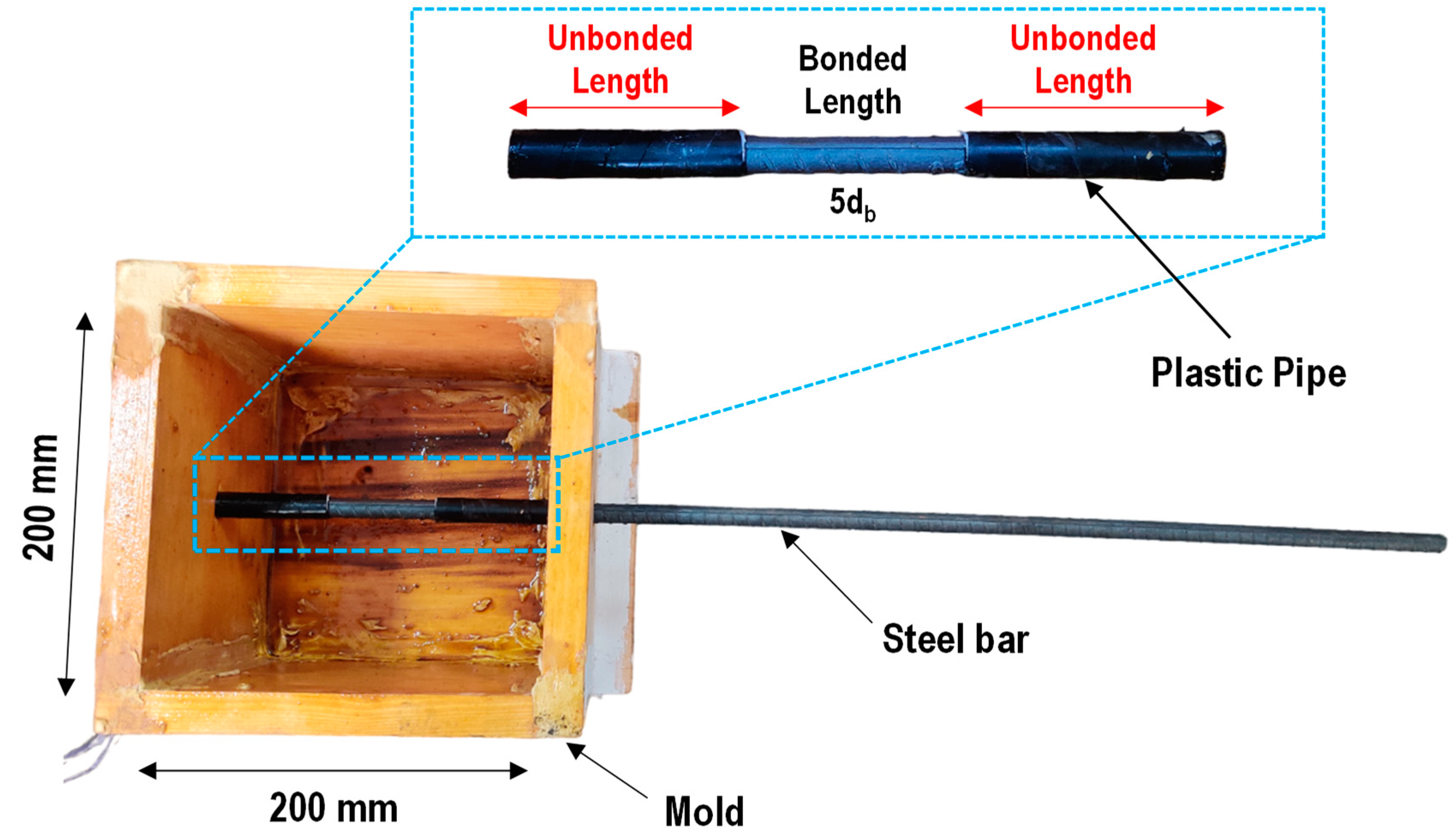
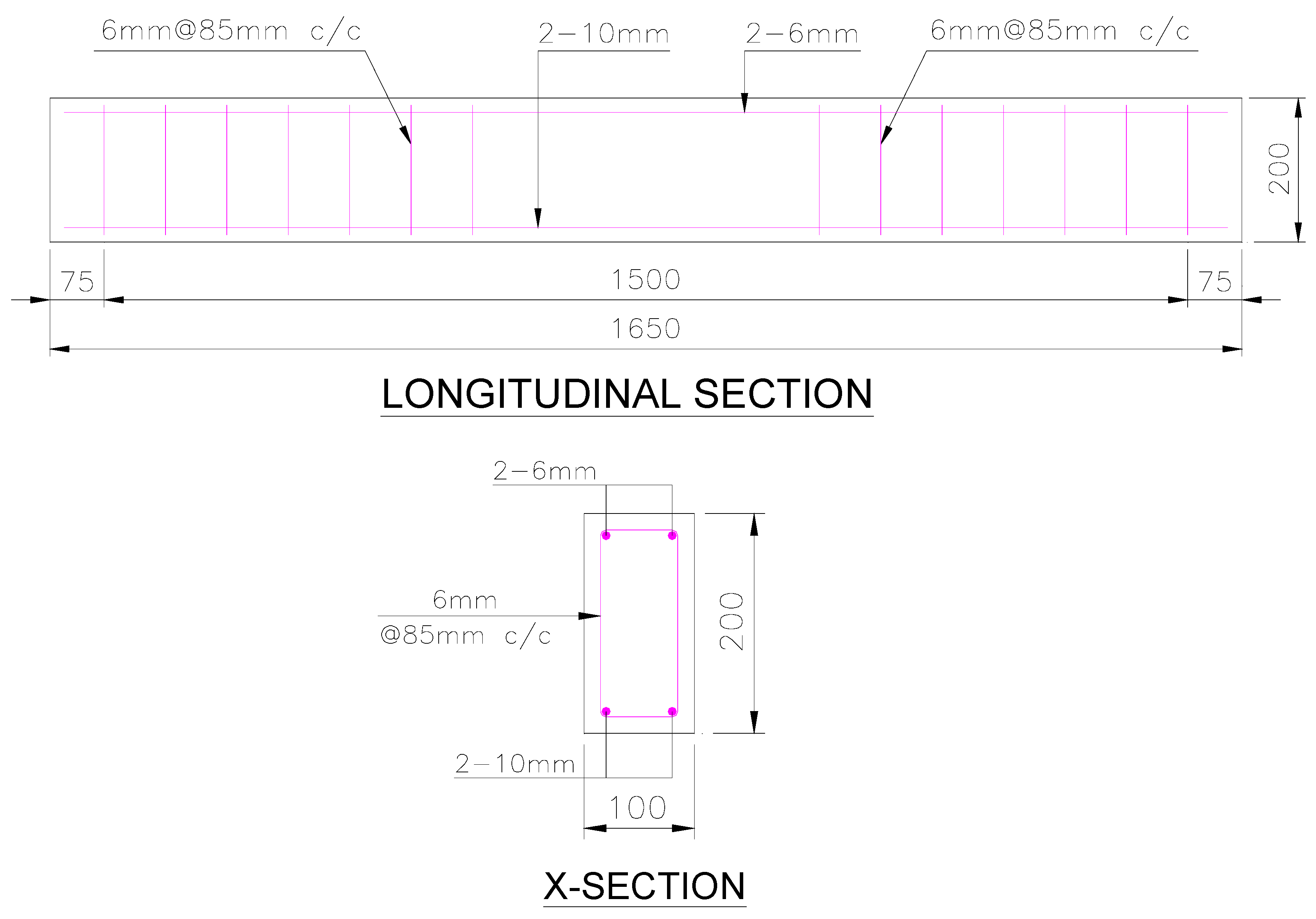

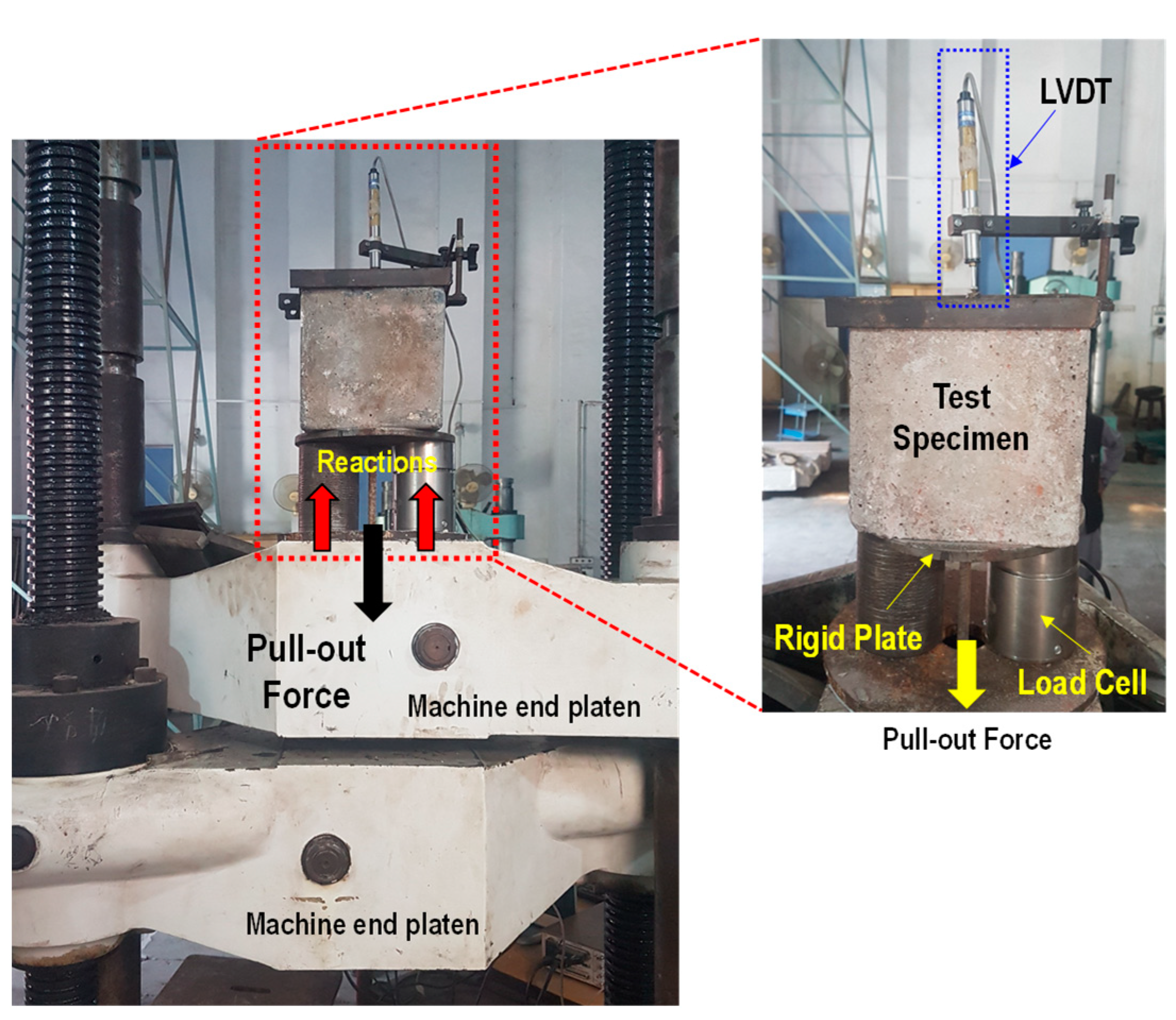
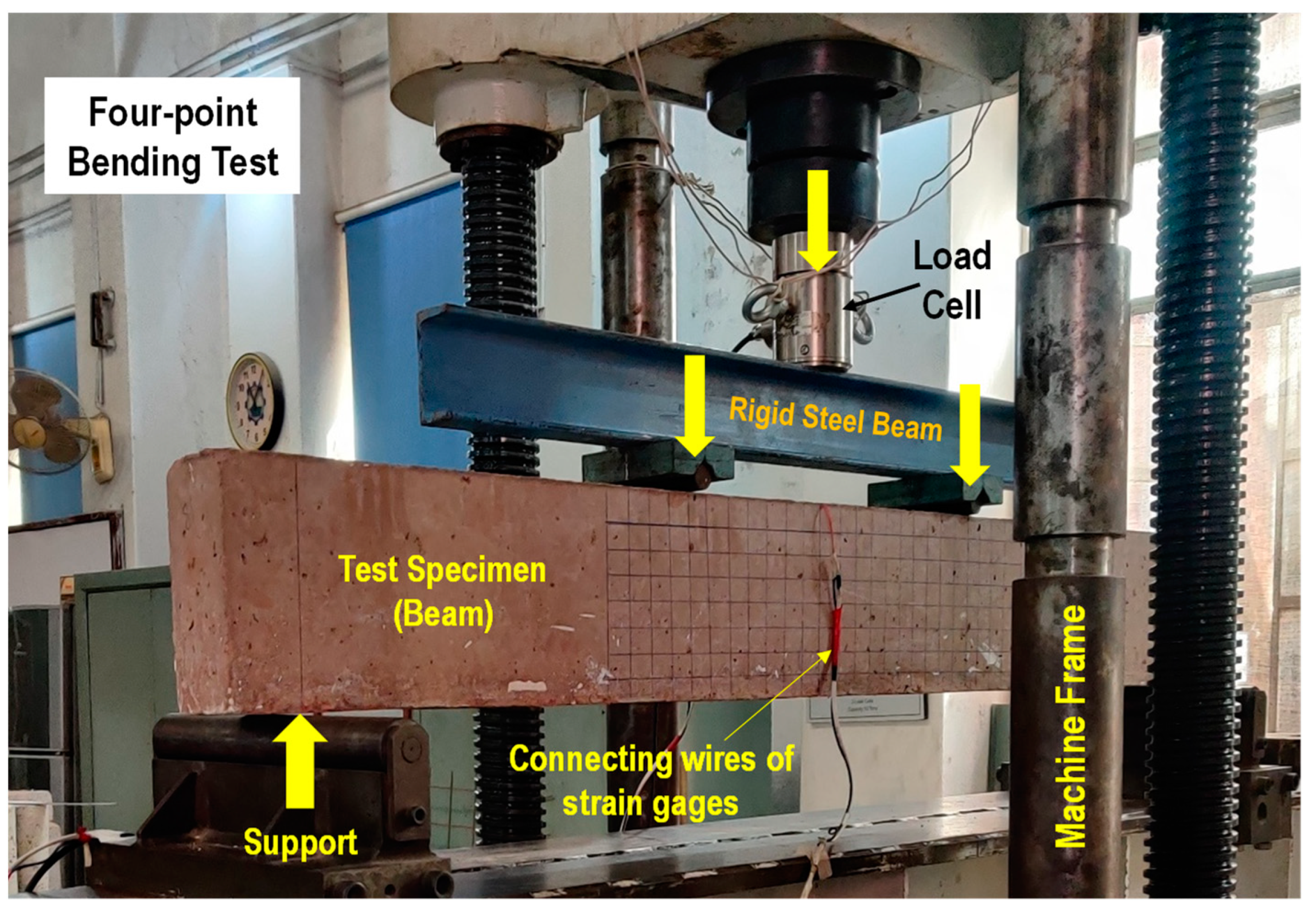
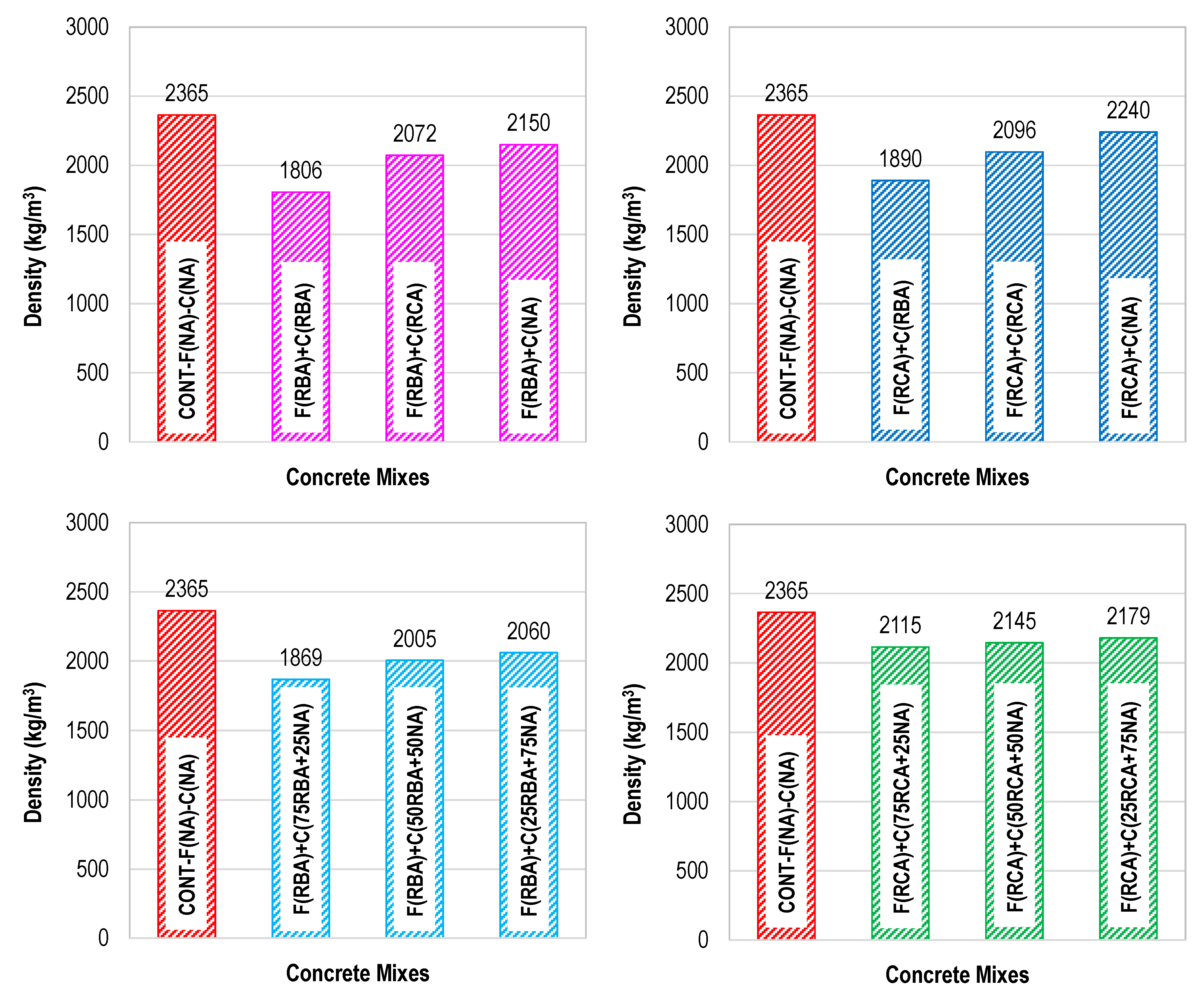
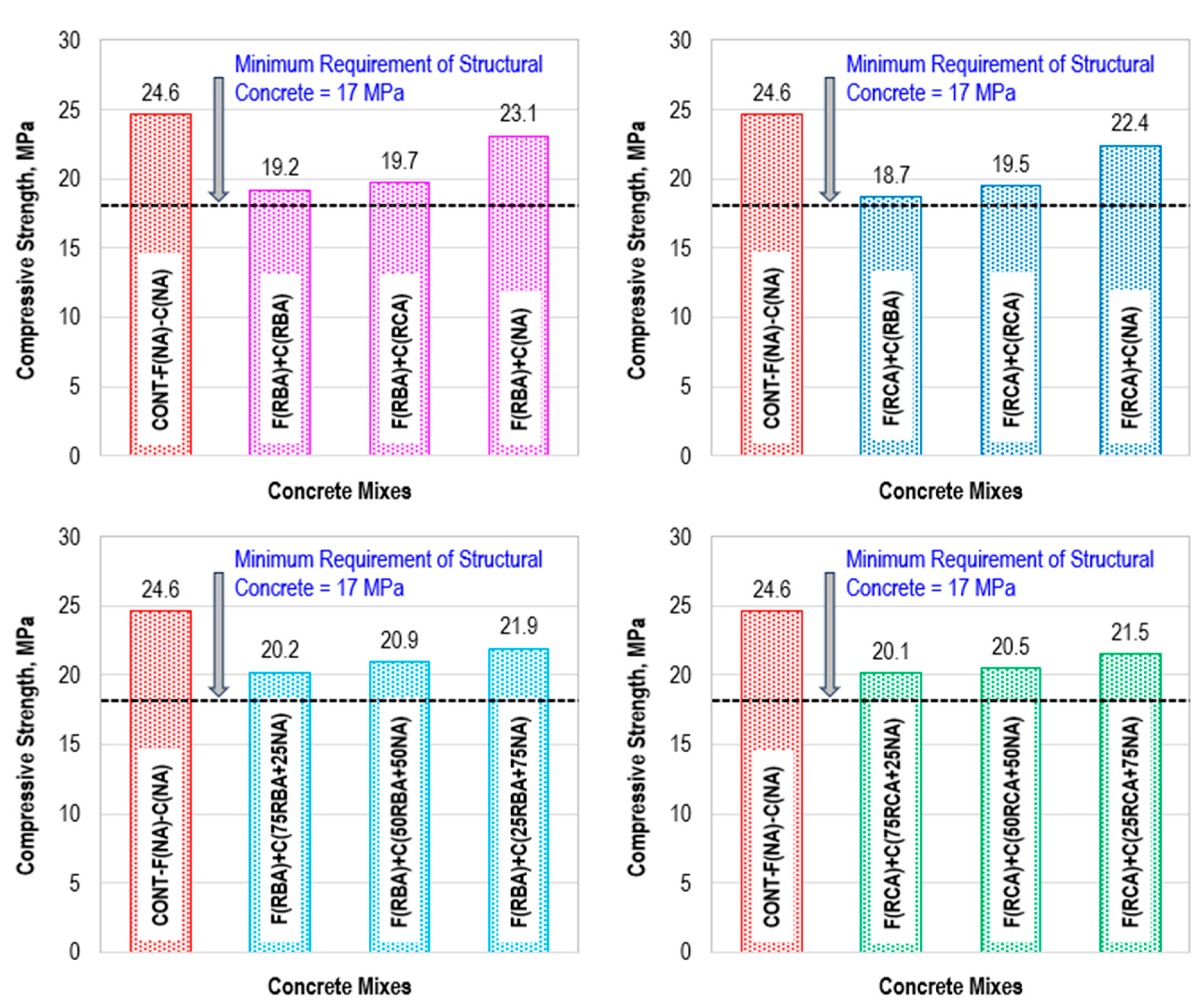

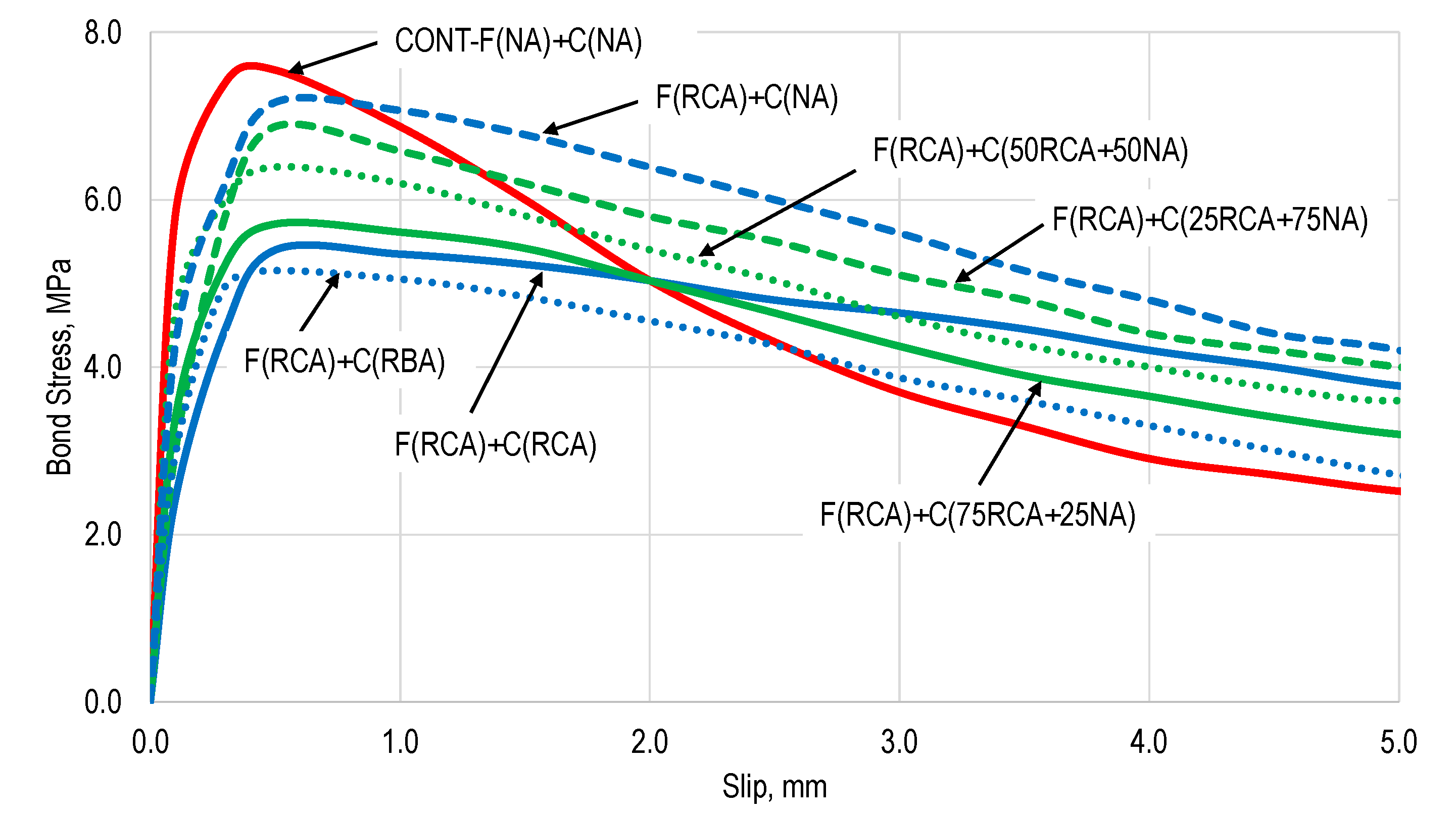


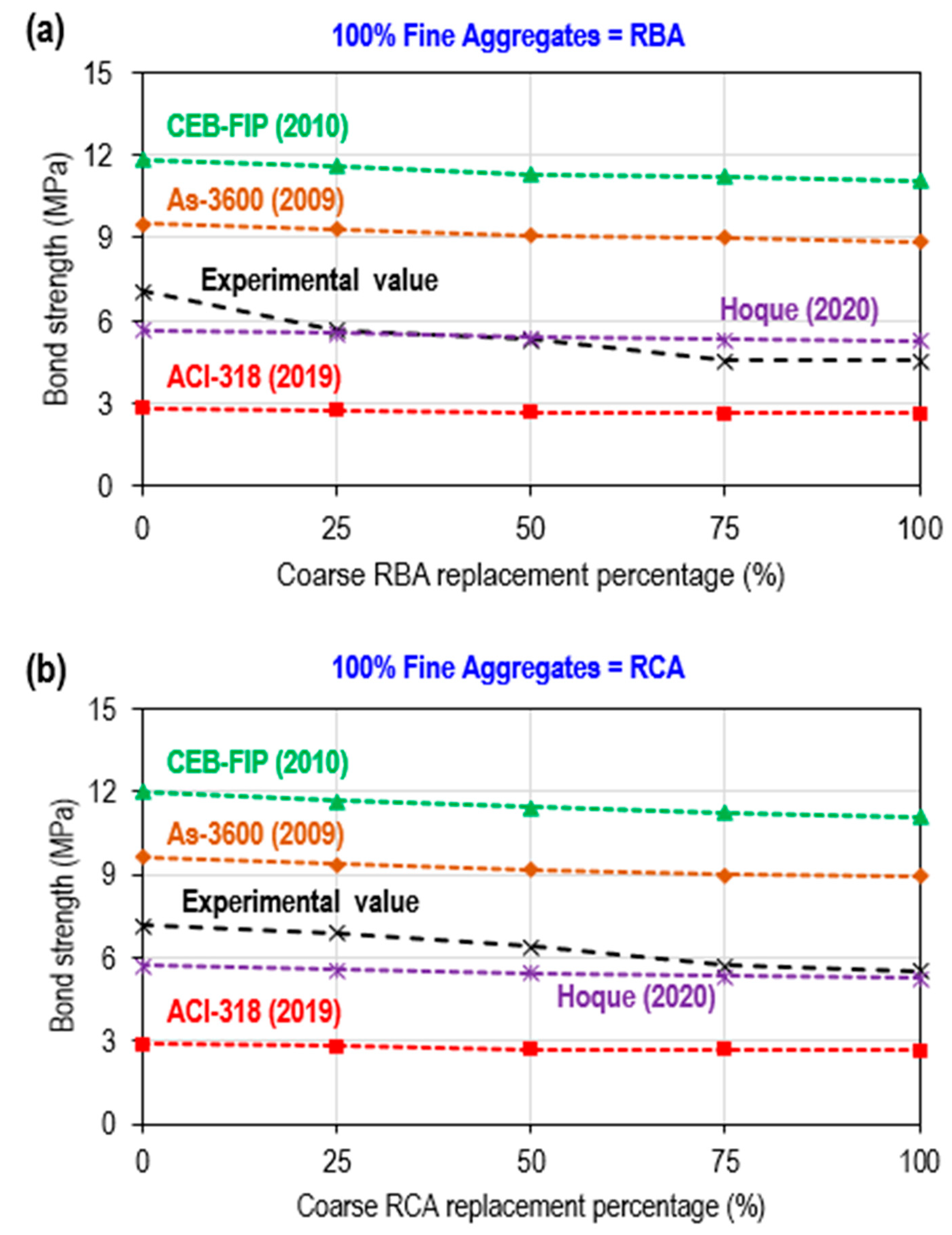
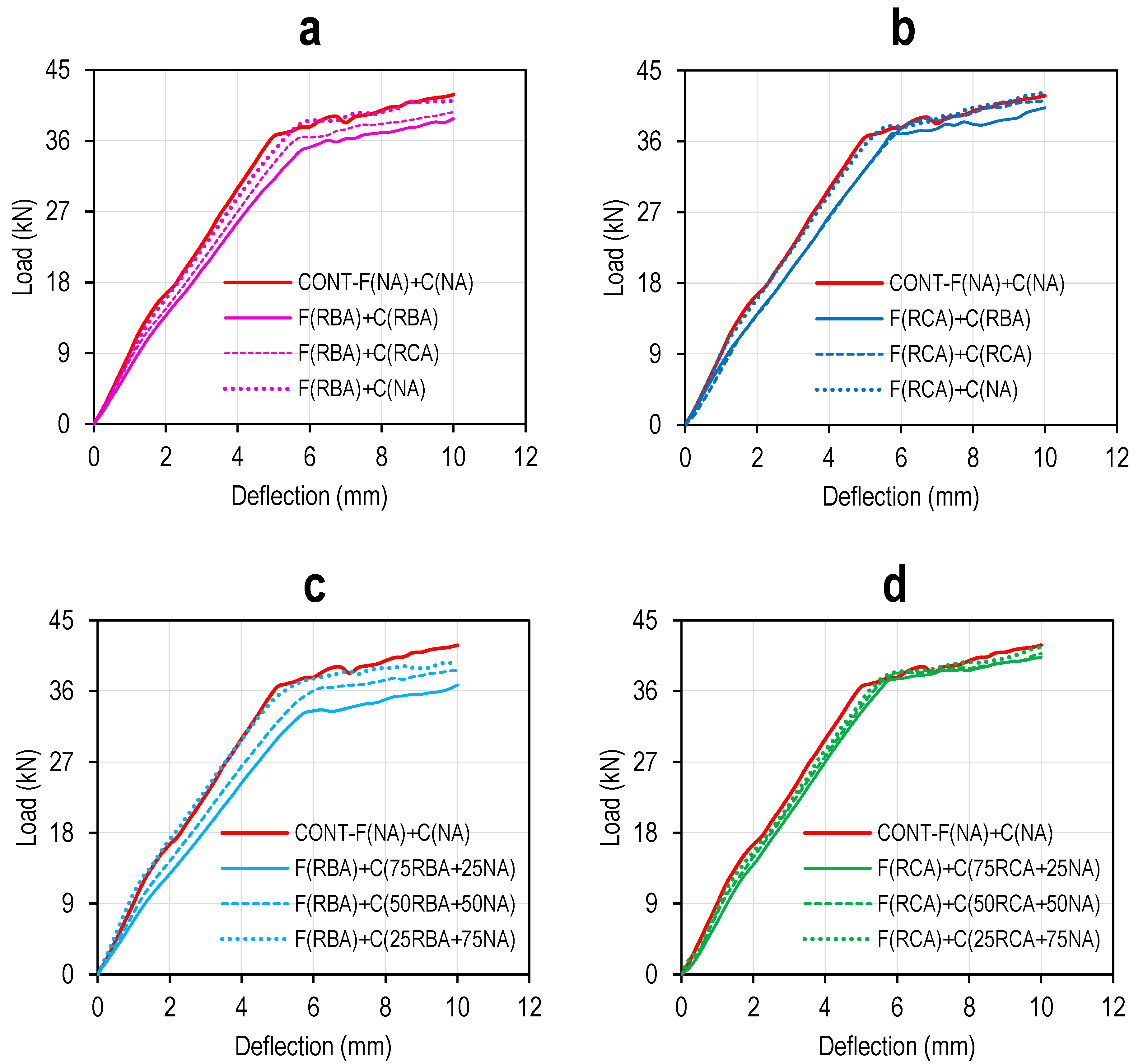
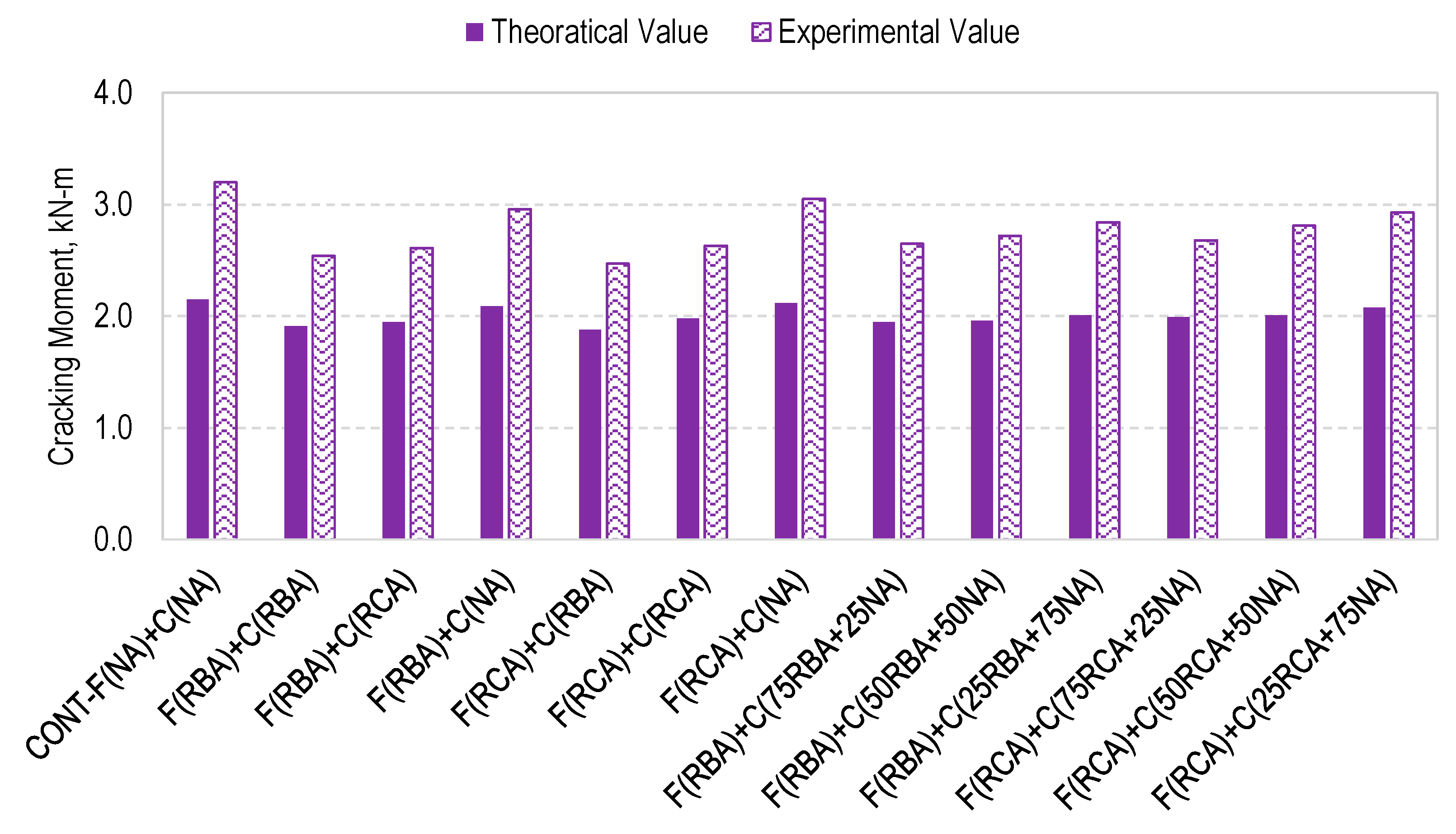
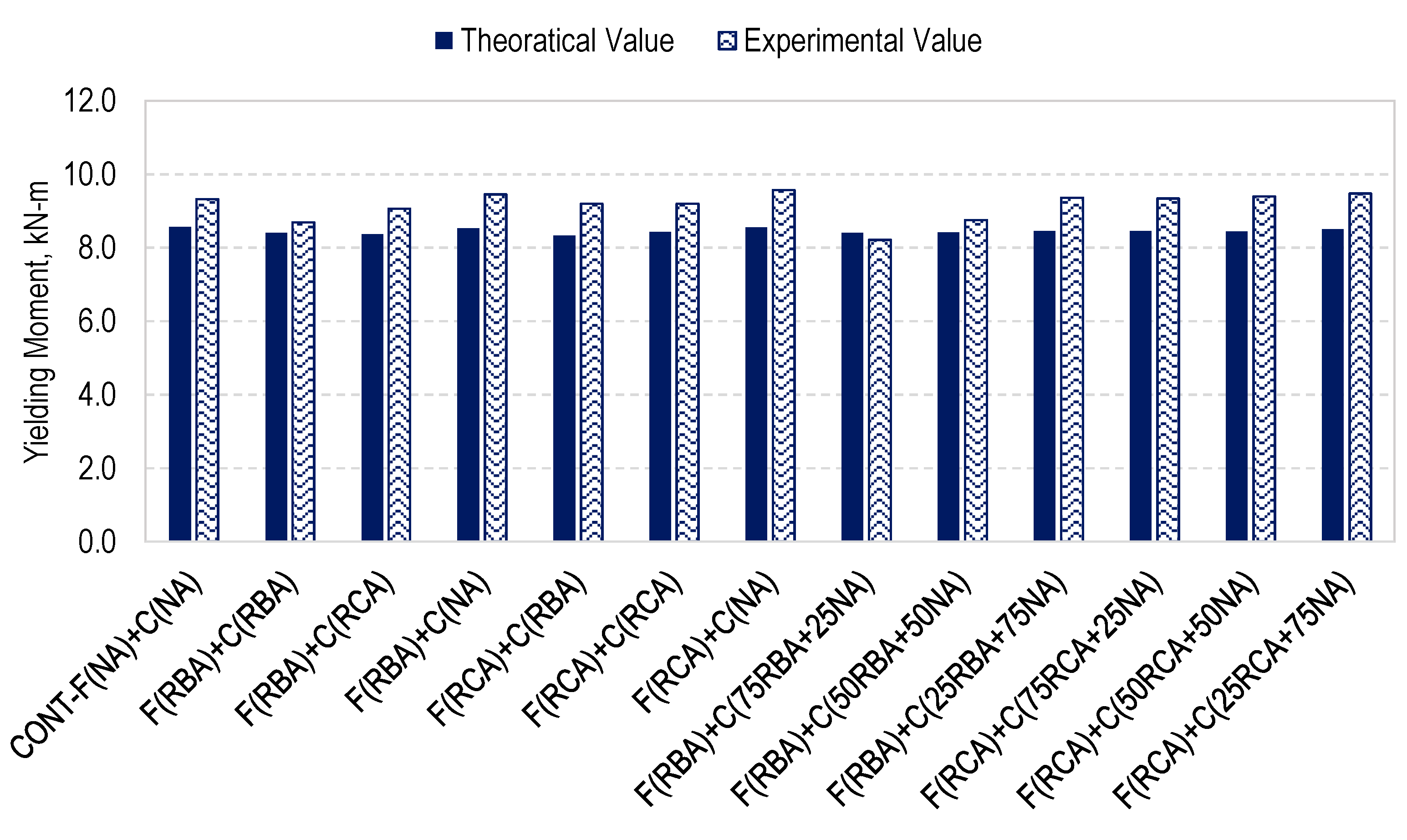
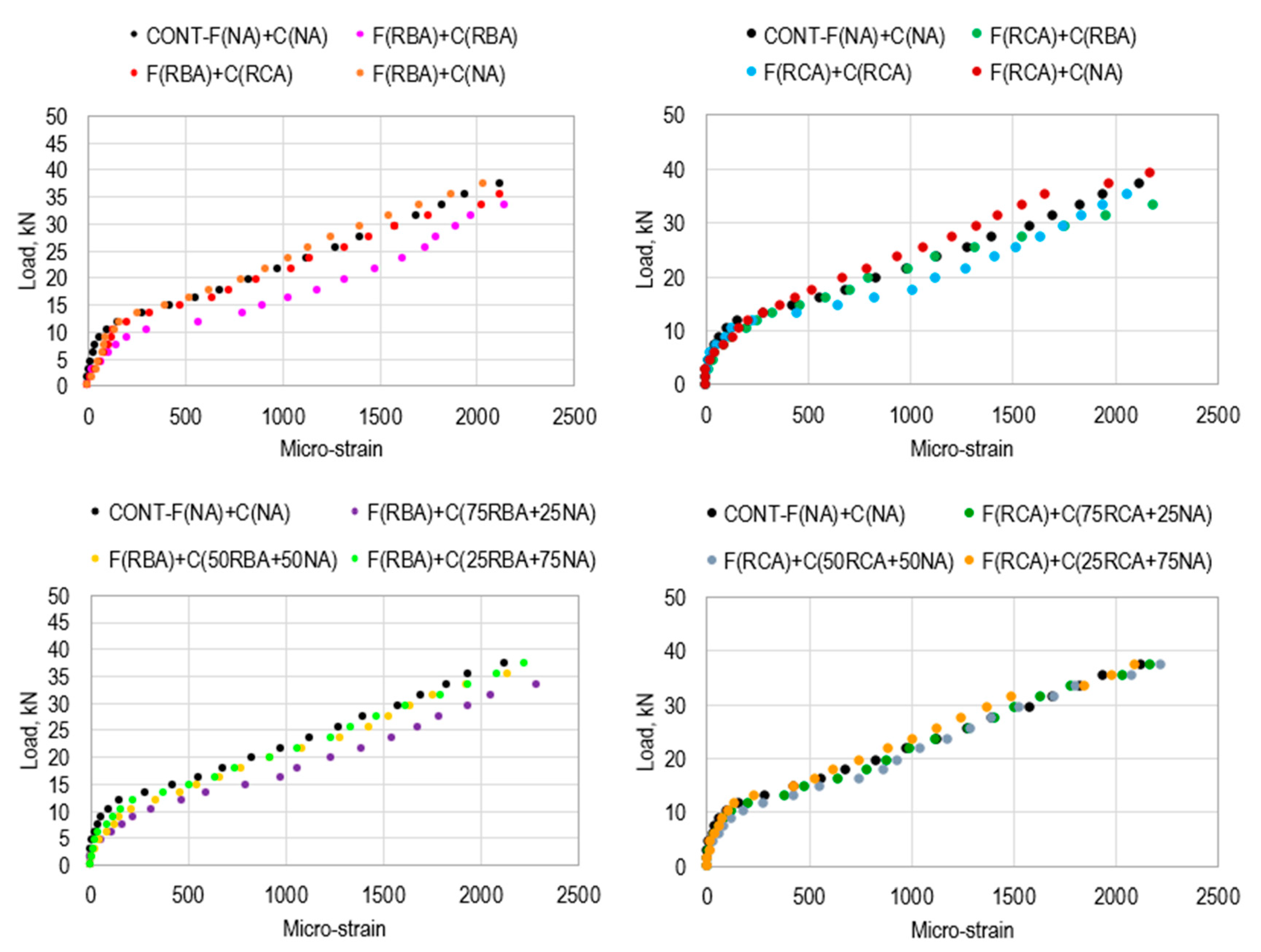
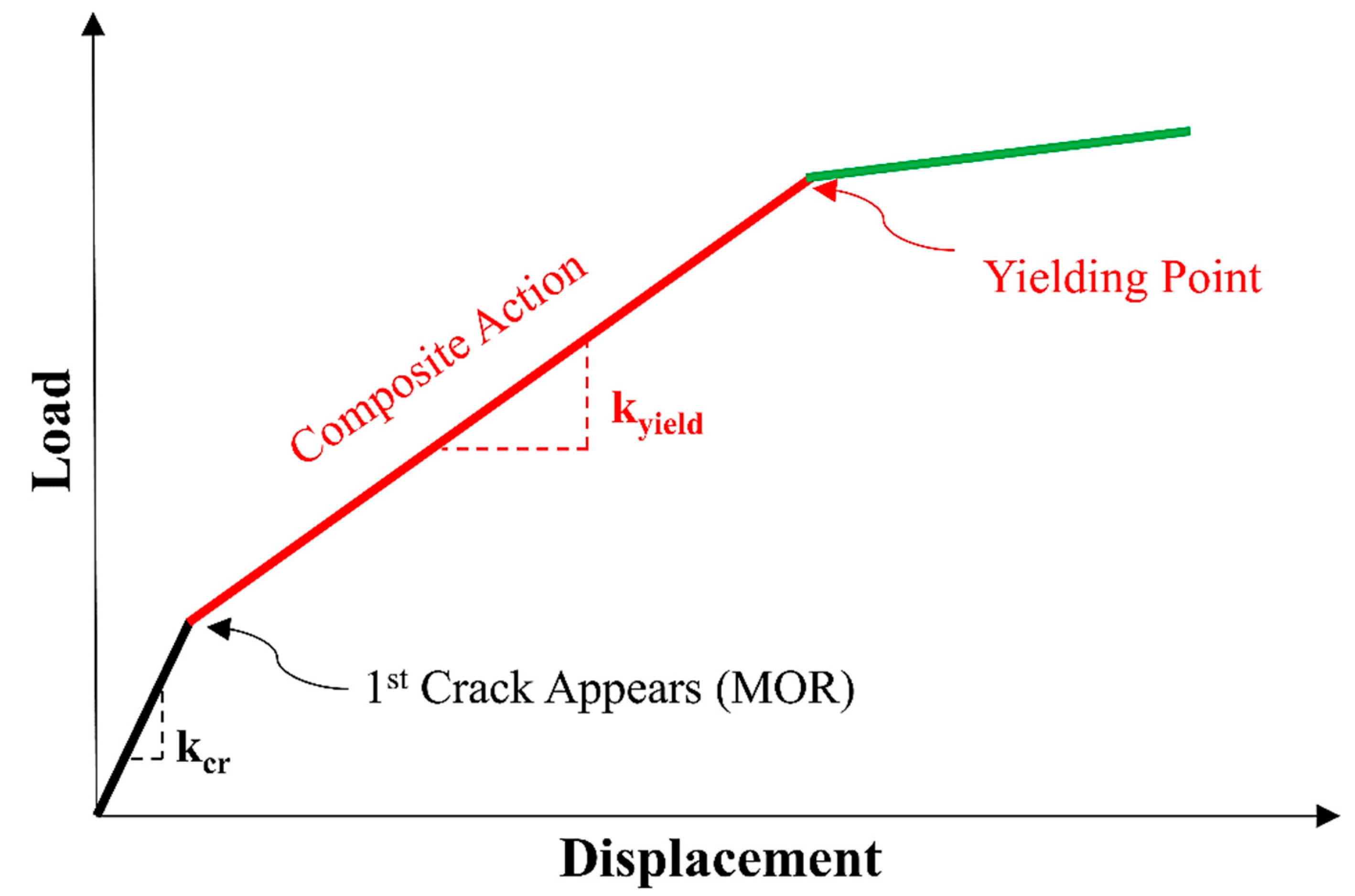



| Properties | Testing Standard | Aggregate Type | |||||
|---|---|---|---|---|---|---|---|
| RCA | RBA | NA | |||||
| Coarse | Fine | Coarse | Fine | Coarse | Fine | ||
| Bulk oven dry-specific gravity | ASTM C127 [58] and ASTM C128 [59] | 2.21 | 2.05 | 1.74 | 1.58 | 2.71 | 2.59 |
| Bulk SSD-specific gravity | 2.49 | 2.29 | 2.04 | 1.85 | 2.85 | 2.75 | |
| Bulk Apparent-Specific Gravity | 2.92 | 2.76 | 2.51 | 2.43 | 3.13 | 2.94 | |
| Water Absorption (%) | 7.87 | 9.5 | 15.25 | 19.25 | 1.9 | 2.24 | |
| Bulk Density (kg/m³) | ASTM C29 [60] | 1321 | 1426.3 | 1290 | 1378.3 | 1532.6 | 1654.6 |
| Crushing Value of Aggregate, ACV (%) | BS 812-110 [61] | 22.4 | - | 38.57 | - | 14.2 | - |
| Impact Value of Aggregate, AIV (%) | BS 812-112 [62] | 18.1 | - | 31.46 | - | 12.78 | - |
| Sr. No | Mix Designation | Fine Aggregates (%) | Coarse Aggregates (%) | ||||
|---|---|---|---|---|---|---|---|
| RBAs | RCAs | NAs | RBAs | RCAs | NAs | ||
| 1 | F(RBA) + C(RBA) | 100 | - | - | 100 | - | - |
| 2 | F(RBA) + C(RCA) | - | 100 | - | |||
| 3 | F(RBA) + C(NA) | - | - | 100 | |||
| 4 | F(RCA) + C(RBA) | - | 100 | - | 100 | - | - |
| 5 | F(RCA) + C(RCA) | - | 100 | - | |||
| 6 | F(RCA) + C(NA) | - | - | 100 | |||
| 7 | F(RBA) + C(75RBA + 25NA) | 100 | - | - | 75 | - | 25 |
| 8 | F(RBA) + C(50RBA + 50NA) | 50 | - | 50 | |||
| 9 | F(RBA) + C(25RBA + 75NA) | 25 | - | 75 | |||
| 10 | F(RCA) + C(75RCA + 25NA) | - | 100 | - | - | 75 | 25 |
| 11 | F(RCA) + C(50RCA + 50NA) | - | 50 | 50 | |||
| 12 | F(RCA) + C(25RCA + 75NA) | - | 25 | 75 | |||
| 13 | CONT-F(NA) + C(NA) | - | - | 100 | - | - | 100 |
| Failure Type | Bond Condition | Bond Strength (MPa) | Equation No. | |
|---|---|---|---|---|
| Splitting Failure | Good | Unconfined | (8) | |
| Confined | (9) | |||
| Other | Unconfined | (10) | ||
| Confined | (11) | |||
| Pull-out failure | Good | (12) | ||
| Other | (13) | |||
Disclaimer/Publisher’s Note: The statements, opinions and data contained in all publications are solely those of the individual author(s) and contributor(s) and not of MDPI and/or the editor(s). MDPI and/or the editor(s) disclaim responsibility for any injury to people or property resulting from any ideas, methods, instructions or products referred to in the content. |
© 2024 by the authors. Licensee MDPI, Basel, Switzerland. This article is an open access article distributed under the terms and conditions of the Creative Commons Attribution (CC BY) license (https://creativecommons.org/licenses/by/4.0/).
Share and Cite
Basit, A.; Hameed, R.; Abbas, S.; Karam, M.S.; Shahzad, S.; Kazmi, S.M.S.; Munir, M.J. Impact of Recycled Concrete and Brick Aggregates on the Flexural and Bond Performance of Reinforced Concrete. Appl. Sci. 2024, 14, 2719. https://doi.org/10.3390/app14072719
Basit A, Hameed R, Abbas S, Karam MS, Shahzad S, Kazmi SMS, Munir MJ. Impact of Recycled Concrete and Brick Aggregates on the Flexural and Bond Performance of Reinforced Concrete. Applied Sciences. 2024; 14(7):2719. https://doi.org/10.3390/app14072719
Chicago/Turabian StyleBasit, Abdul, Rashid Hameed, Safeer Abbas, Muhammad Shoaib Karam, Shaban Shahzad, Syed Minhaj Saleem Kazmi, and Muhammad Junaid Munir. 2024. "Impact of Recycled Concrete and Brick Aggregates on the Flexural and Bond Performance of Reinforced Concrete" Applied Sciences 14, no. 7: 2719. https://doi.org/10.3390/app14072719
APA StyleBasit, A., Hameed, R., Abbas, S., Karam, M. S., Shahzad, S., Kazmi, S. M. S., & Munir, M. J. (2024). Impact of Recycled Concrete and Brick Aggregates on the Flexural and Bond Performance of Reinforced Concrete. Applied Sciences, 14(7), 2719. https://doi.org/10.3390/app14072719








